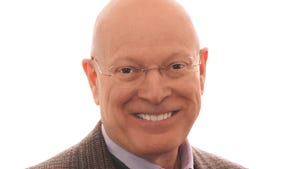ARMOUR Residential REIT, Inc. (NYSE:ARR) Q3 2022 Earnings Conference Call October 27, 2022 8:00 AM ET
Company Participants
Jim Mountain – Chief Financial Officer
Scott Ulm – Co-Chief Executive Officer
Jeff Zimmer – Co-Chief Executive Officer
Mark Gruber – Chief Investment Officer
Conference Call Participants
Doug Harter – Credit Suisse
Trevor Cranston – JMP Securities
Jason Stewart – JonesTrading
Christopher Nolan – Ladenburg Thalmann
Matthew Howlett – B. Riley
Operator
Good morning, and welcome to the ARMOUR Residential REIT’s Third Quarter 2022 Earnings Conference Call. All participants will be in listen-only mode. [Operator Instructions] After today’s presentation, there will be an opportunity to ask questions. [Operator Instructions] Please note, this event is being recorded.
I would now like to turn the conference over to Jim Mountain, Chief Financial Officer. Please go ahead.
Jim Mountain
Thank you, Drew, and thank you all for joining our call to discuss ARMOUR Residential REIT’s third quarter 2022 results. This morning I’m joined by ARMOUR’s Co-CEOs, Scott Ulm and Jeff Zimmer and by Mark Gruber, our CIO. By now, everyone has access to ARMOUR’s earnings release, which can be found on ARMOUR’s website, www.armourreit.com.
This conference call includes forward-looking statements, which are intended to be subject to the Safe Harbor protections provided by the Private Securities Litigation Reform Act of 1995. The Risk Factors section of ARMOUR’s periodic reports filed with the Securities and Exchange Commission describe certain factors beyond ARMOUR’s control that could cause actual results to differ materially from those expressed or implied in these forward-looking statements.
Those periodic filings can be found on the SEC’s website at www.sec.gov. All of today’s forward-looking statements are subject to change without notice. We disclaim any obligation to update them unless required by law. Also, today’s discussion refers to certain non-GAAP measures. These measures are reconciled with comparable GAAP measures in our earnings release. An online replay of this conference call will be available on ARMOUR’s website shortly and will continue for one year.
Net interest margin for the quarter was 2.21%, the decrease of 1 basis point compared to Q2 2022. ARMOUR’s Q3 comprehensive loss related to common shareholders was $155.7 million, which includes $144.3 million of GAAP net loss. Distributable earnings available to common shareholders was $38.8 million or $0.32 per common share.
This non-GAAP measure is based on historical cost and excludes gains or losses from security sales and early terminations of derivatives, as well as market value adjustments. It does include TBA Drop Income. ARMOUR paid monthly common dividends of $0.10 per common share during the quarter and has announced dividends at that rate for October and November 2022.
The outlook for dividends appears to be stable based on current conditions. However, we will keep a keen eye on economic conditions, which could change rapidly in this environment. Taken together with the contractual dividends on preferred stock ARMOUR has made cumulative distributions to stockholders of over $1.9 billion throughout our history.
ACM, the company’s external manager continues to voluntarily waive $1.95 million of its management fee, which offsets Q3 operating expenses. ARMOUR was proactive in managing its common share capital base in Q3, resulting in positive accretion to stockholders of $0.14 per share.
During the quarter, we issued over 22,733,000 million shares of common stock through our ATM programs that raised $167.2 million of capital after fees and expenses. That represents an average price of $7.36 per common share. In September, we repurchased 780,000 shares of common stock at an average cost of $4.96 per share. For context, Q3 volume weighted average price was $6.89 per common share.
Quarter-end book value was $5.83 per common share. As of last night, the 26, we estimate that book value for common share was between $5.26 and $5.31 per common share, again, between $5.26 and $5.31. As we finalize our tax projections for calendar 2022, we expect that all common stock dividends and Series E Preferred Stock dividends will be treated for federal income tax purposes as a returns of capital and not currently taxable to our shareholders. This is comparable to last year’s tax results.
Looking forward to 2023, we forecast that Series C preferred stock dividends for 2023 will likely be treated as fully taxable ordinary income to those shareholders. Common dividends for 2023 will also likely be treated at least partially, as taxable ordinary income.
Now, I want to turn the call over to Co-Chief Executive Officer, Scott Ulm to discuss ARMOUR’s portfolio and current strategy in more detail. Scott?
Scott Ulm
Thank, Jim. In respect to normalize high inflation the Fed has delivered the fastest pace of tightening since the 1980s, when former Fed Chair Paul Volcker raised the Fed funds rate to nearly 20%. During the third quarter, the Fed fund rate rose by 150 basis points to 3.25%. The two-year treasury yield rose by 132 basis points to 4.28% and the 10-year treasury yield rose by 91 basis points to 3.83%.
The historic upsurge in risk-free borrowing rates combined with the start of quantitative tightening of $95 billion per month, sent 2022 total returns on U.S. treasury bonds to negative 13.1%. It’s worst on record. The UK pension industry, which six weeks ago most of us had very limited knowledge of emerges a catalyst for a major risk off trade and interest rates around the globe, such as the market we’re in. Our March 2020 experience served as a valuable tool to stay ahead of the increased volatility by proactively managing our dollar liquidity and MBS portfolio risks.
In September and October, we reduced our mortgage portfolio by $2.9 billion of MBS pools with 3.5 to 4.5 coupons, raising the overall liquidity to $591 million and trimming our implied leverage down to 7 times as of 10/25. Since the beginning of September, we’ve decreased our spread duration by 32% and our net duration gap was 0.79.
Despite dialing down the overall risk levels, we still maintain a healthy exposure to the MBS market, which in our view is approaching levels of incredible value seen prior only during the great financial crisis a decade and a half ago. With MBS spreads just 20 to 30 basis points lower than the widest levels of 2008, we believe the risk reward ratio now firmly favors the investor. To further improve our resilience to rising turbulence of the market, ARMOUR raised $167 million of new capital in the third quarter through our ATM share issuance program that was accretive to our shareholders by $0.14 and insured healthy levels of cash liquidity even under the harshest stress test scenarios.
Repo financing remains another strong pillar of our business in these markets, shielded from greater volatility observed in nearly all financial markets, funding of our high quality MBS assets remain liquid and plentiful. ARMOUR is active with 20 different repo counterparties and approximately 50% of our borrower balance, funded through our broker dealer affiliate BUCKLER Securities.
Our business relationship with BUCKLER provides us with a particular advantage in the mortgage REIT sector, securing our lifeline to the funding markets even in times of great distress. We have very limited dependence on third party repo providers that are dependent on the FICC, a 104% of a repo book is hedged with current fixed to floating OAS and so far index swaps absorbing the impact of the fed hiking cycle on overall funding rates due to the daily floating receive leg of the swap. If we include the notional amount of all of our interest rate hedges, our funding is covered by 125%.
ARMOUR is vastly reduced its exposure to premiums paid on specified pools and has high access liquidity as a percentage of total capital, both of which better position the balance sheet to whether the unexpected turns that the rise in market volatility can bring. We believe the expected slowdown in the pace of interest rate hikes in 2023 will provide a catalyst to lower volatility and reward agency MBS investors who have stayed the course with outstanding returns.
We expect our all agency MBS strategy will deliver compelling returns in the future without the risk of credit. We view our current dividend of $0.10 as appropriate. In this volatile environment, that is particularly effective book value, we will as always continue to evaluate the level of the dividend. We’re also mindful that this environment could deliver upside surprises as well that can move our metrics substantially.
We’ll now open the line to questions.
Question-and-Answer Session
Operator
We will now begin the question-and-answer session. [Operator Instructions] The first question comes from Doug Harter with Credit Suisse. Please go ahead.
Doug Harter
Thanks. Just hoping to get a little more clarity around your comment. You described the environment for the dividend as stable. To me, it feels like the current environment has kind of been anything, but stable. So just hoping to kind of get a little bit more detail around that comment?
Jeff Zimmer
Hey, Doug. Good morning. Jeff Zimmer here. So most of our portfolio was constructed, essentially all of it constructed before the wild swings in prices in almost every asset class started in late August. So the comment is that we have constructed a portfolio under stable environment. The subsequent environment is not stable, but right now the dividend that we’re paying out based on investments and swaps put on a while ago is very stable.
As Scott also noted conditions could change. They could change to the upside. Just like you lose $1.5 to $2 of book value very quickly, if you stay the course like we have and we still invested very much so in agency mortgage backed securities. You can get book value back up, which would then mean that dividend yields would not look like, they would look like today.
Doug Harter
Got it. I guess, given the further decline in book value in October, any updates on what the portfolio size looks like today, just as you’ve reacted to the environment.
Jeff Zimmer
I do know the liquidity as of last night was $525 million, cash of $250 million and the box of $275 million. That liquidity is increased because some of our transactions from earlier in September finally settled in the month of October. I think I’ll hand it over to Mark Gruber. And Mark, I think it’d be okay to note the size of the portfolio at this point in time.
Mark Gruber
Yes. Sure, Doug. It’s – the portfolio is about $6.5 billion in size right now.
Jeff Zimmer
So our leverage is I think we mentioned that earlier, but it’s $6.5 billion and that includes some of the treasuries. Leverage this morning is $6.9 billion. That would be implied leverage in actual leverage. We only have a $100 million of outstanding forward settles Doug. So you’re implied in your actual is about $6.9 billion with the duration of 0.6 to 0.7 range.
Doug Harter
Okay, thank you.
Jeff Zimmer
All right. Thanks for calling in.
Operator
The next question comes from Trevor Cranston with JMP Securities. Please go ahead.
Trevor Cranston
Hey, thanks. Good morning. Follow-up on the question about the current leverage and portfolio size. So the portfolio size has obviously been declining somewhat in September and October. And you also mentioned, the spreads are obviously very wide and there’s some potential for them to tighten at some point. So I guess, can you talk about how you’re sort of balancing the potential for spreads tightening and get some book value back versus selling assets and kind of keeping leverage at a conservative level in order to manage through the current market volatility?
Jeff Zimmer
Yes. Trevor, hi. It’s Jeff, again. I just – could you actually say what your exact question is? I’m not clear what you need us to address.
Trevor Cranston
So I guess, I’m – the question is sort of – you mentioned there’s potential for spreads to tighten back in, but at the same time, you guys are obviously reducing the portfolio size. So I guess, the question is like how you were – kind of how you were coming up with the leverage target in today’s market and kind of what you view as the near term upside versus downside risk to spreads.
Jeff Zimmer
Yes. So we believe that it’d be highly unlikely to see spreads wide and much more than 20 OAS from here. That would reach the worst level seen in that the OA period. Anything could happen, a drop could be – bomb could be dropped in Ukraine, there could be some other events that are out of our control. So we are keeping a risk profile reduced, but yet have the optionality to increase it very rapidly. For example, we own hundreds of millions dollars of treasuries and Mark can tell you how much in a moment we own today.
Those can quickly be sold to be exchange in the mortgage backed securities at today’s wide spreads. But we want to maintain this liquidity for a while longer. You don’t know until you look in the rear view mirror of that exact moment in time to address the risk profile and start increasing it, but at this point, we’re going to keep it reduced and over time when the mountain seems a little safer to ski on, we’ll go ahead and start increasing our exposure again into the MBS world.
And to Scott’s point, the investments are very good right here, but we do want to maintain our high level of risk management profile right here and we’re going to maintain a lot of cash and a lot of liquidity. Mark, you want to talk about the treasury portfolio and where leverage could possibly go from here?
Mark Gruber
Sure. So we have about $450 million of treasuries. So obviously, that can be swapped into MBS. But we also have the ability, historically, right, we’ve had leverage up to 9. So we have probably two turns of leverage we could add here. And to your question, when we get back in. We have some metrics we’re using internally things like volatility and spreads and such. So we’re looking for those metrics to hit targets that’s when we would step back in. We’re just not there yet.
Trevor Cranston
Okay. Got it. Appreciate the comments. Thank you.
Jeff Zimmer
Thank you.
Operator
The next question comes from Jason Stewart with JonesTrading. Please go ahead.
Jason Stewart
Hey, good morning. Thanks for taking the question. I wanted to follow-up on Doug’s question about the dividend and how you view, I mean, I guess, the yield on the stock versus the current economic environment, which sounds like you feel pretty good about covering that dividend, but do you feel like you get credit for that?
Jeff Zimmer
Anytime you look at a stock and your dividend yields are north to 20%, you’re going to just take a deeper look and say, hi, that seems off market, but you can’t compare us to an industrial company. You can’t compare us to any other company, but a financial company. And when markets change very rapidly as they did from the last week in August, really through today, okay, metrics change quickly and what you do is have to go back and look at what I – how I answered Doug. We put together a portfolio over a number of quarters that hasn’t really changed that much for a few sales that took place in September and early October.
So the portfolio is supporting the current dividend yield right now. Also to Scott’s point, market conditions could improve. So you get 30, 40 OAS of tightening, which would be a normalized OAS over the last decade or so. All of a sudden book values back up and you’re looking at the returns and you’re saying, gosh, that’s a 15% return.
So that’s not kind of off market for what this sector’s had over the years. But we take a look at it every week, we make decisions and every quarter we talk to the board and actually, as you know, we announce the dividend monthly. And if you want to go back a number of years, we actually took a leadership role in that regard. We were the first REIT to start paying monthly.
So that also gives us the ability to go ahead and say, hey, we’re not going to wait till the end of the quarter. Things have changed. We’re going to lower the dividend or we’re going to raise the dividend based on what conditions are. But for the last four or five quarters, Scott has been very clear that we look at out to the medium term and we set that dividend based on what we see over a period of time, not just what’s happening today. So if any changes are made, it’s because we believe is a group and the Board agrees that conditions have changed, that’s in over the medium-term XYZ should be the given level. Is that helpful to you?
Jason Stewart
Yes. Thank you. Last question from me. Are you expecting any meaningful changes at FHFA with regard to credit policies? The way they look at the market liquidity, credit, et cetera?
Jeff Zimmer
I’ll ask Mark to finish off on this, but we have particularly good insight now because we have BUCKLER the broker dealer and our new CEO of BUCKLER has a litany of experience with the different agencies and we talks to them directly. We don’t see anything, particularly if you want to even talk about the FICC any changes right there, regarding the FHFA, I’ll hand it over to Mark to see if he noted any changes there.
Mark Gruber
No, I wouldn’t say that we have any particular insight into what we think they’re going to do at this time.
Jason Stewart
Okay. Thank you. Appreciate it.
Operator
The next question comes from Christopher Nolan with Ladenburg Thalmann. Please go ahead.
Christopher Nolan
Hey guys, just a couple questions. Was the $0.14 accretion from both repurchases and share issuances?
Scott Ulm
Yes. Yes, it was. Though, we – there’s a big difference in the size. We were on both sides of the market. We always look at both sides of the market. And when it just gets too cheap, we’ll buy some. But we were fortunate to be able to execute some of our sales significantly above where we ended up.
Christopher Nolan
Great. And then net interest income decline quarter-over-quarter despite relatively stable net interest margin and higher earning asset volumes. What was the reason for the decline?
Jeff Zimmer
Jim, I’ll address that. Say again.
Christopher Nolan
The net interest income decline in the quarter despite larger portfolio and stable margins. Just trying to see what was the catalyst for the decline.
Jeff Zimmer
Repo cost of funds ended up running up just a little bit and there’s a little bit of friction and mismatch in the index and reset timing of the swaps versus the actual tenure of the repos that we roll. So that’s as much frictional noise as anything.
Christopher Nolan
Great. And then the third question I have, and sort of a follow-up to what Trevor was, I think leading up to, is right now given where your stock price is and given the amount of liquidity that you have in terms of cash and unlevered securities, but my estimate, your cash unlevered securities is $3.56 a share, or roughly 70% of your share price.
And I guess the risk reward question is, why not take down the portfolio way down, take the leverage way off given the risks in this environment? I’m just trying to and I’m not criticizing, I’m just really trying to get a idea what the thought process is.
Jeff Zimmer
6.9 times leverage implied and actual debt to equity, which it is this morning, is about the lowest we’ve been since inception I think in 2020, we’ve got under that for a cup of coffee, why things got a little crazy. But the environment in our liquidity supports exactly where we are right now. And if we wanted to be lower, we would be, but we don’t want to be lower and we actually want to continue to have exposure to an asset class that has cheapened up considerably.
And if we start selling all that asset class, you have no opportunity to take advantage of it when things normalize. So we have enough exposure to be able to appreciate book value and opportunities when things normalize. Yet, we have liquidity based on our treasuries and our cash position to be able to move and shake a little bit in case things do get more volatile for a short period of time. So we are where we want to be and we’re opportunistic, but we’re also being very considered of the volatility in the marketplace. I hope that’s helpful.
Christopher Nolan
Yes. Okay.
Scott Ulm
That is market timing and certainly there have been some days when we wish we were not long mortgage backed securities, but that’s the business we’re in. And I think we recognize that we are unlikely to be able to call market timing precisely. Maybe generally, we can sense as Mark said through a variety of metrics we follow when timing is more propitious than others.
But to take the portfolio way down, take it way back up, and to get all that right is a – that’s a heavy lift. So I think our investors expect us by the name of the company to be long mortgage backed securities. We vary that, we try to be judicious about it, we try to be safe about it. But at the end of the day, that’s the business we’re in.
Christopher Nolan
Great. Thank you for the clarification.
Mark Gruber
Great. Thanks for calling in.
Operator
The next question comes from Matthew Howlett with B. Riley. Please go ahead.
Matthew Howlett
Good morning, guys. Thanks for taking my question. Just to follow-up on that. Jeff or Scott, when does asset selection collateral session become important? I mean at some point do you feel like speeds now look like they’re at five CPR. At some point, do you feel like you may have to move portfolio to focus on slower – potentially slower paying pools if rates do decline next year?
Jim Mountain
So one thing that we discussed in previous calls is what is the company’s exposure to specified premiums? And we’ll talk about that for a second here. A year ago we may have had $150 million exposure to specified premiums, and that means the amount you paid over TBA prices to buy assets with characteristics whose prepays will be very stable. And by the way, they may be stable at a fast rate, which is okay, okay. Or they may be stable at a slow rate, but at least you have a better idea of where they’re going to be.
So we have reduced that exposure to, I believe close to around $30 million. So very little bit of our balance sheet, but yet our portfolio still exhibits. I think it’s – and Mark, correct me if I’m wrong, 70% to 80% of our portfolio still has specified pools that exhibit characteristics that are stabilizing factors in understanding what the prepayments will be in the future. And we have a diversified portfolio from 2.5s all the way up to 5.5s. We may have purchased some 6s. Mark, you want to enhance on those comments?
Mark Gruber
Sure. So, yes, we are very aware of the type of collateral purchasing. We do look for stories that will be slow in environments when rates go lower. And you can buy some of those stories cheap these days. But with the coupon stack moving up so fast, that hasn’t been basically the primary investment metric.
But it is a concern. We know as we moved up in coupon, we’re adding convexity to the portfolio and an environment, when rates could rapidly decrease who knows when the Fed turns and pivots. But if there is a catalyst where they have to do that, we’re making sure the portfolio is set up for that too.
Matthew Howlett
And so what you’re saying if you still feel that your – and the declining rate scenario, if it happened, today or tomorrow that your book was still prepays slower than generics and you still have those characteristics in it.
Mark Gruber
Correct, billion those pay ups don’t really cost a lot these days.
Matthew Howlett
Right. No, great. It’s good to hear that. And then Jeff, I’d love to hear you just last time you talked about potentially what you thought the Fed would do next year, and I think you look at the macro environment, I think you have two variables with the Fed. Will they stop? Will they potentially ease? And then what do you think they do with potentially outright selling MBS? Do you think that at some point will become viable?
Jim Mountain
So here’s what our firm believes. Our firm believes that they’ll increase by 75 basis points in November. And I would’ve said a month ago, we would’ve said 75 in December. I think as a group now we’re more like 50, and then we believe they’re going to watch and wait for a while and let the data go ahead and catch up with the rest of the world, right?
And that takes a quarter or two, okay? We do not believe at this point that they’re going to make asset sales in the mortgage backed securities arena. And look at, as we said in the last call, that certainly could change, but the regular mortgage rate standing rate right now is 7.15%. The housing market is going in reverse very, very quickly. And they – the Fed wants that, but they also don’t want to make it so upsetting that the metrics of everyday life – start to get ruined for people.
They just want it to slowdown. So we don’t expect right now that they’re going to make any sales. There’s research out there that would suggest they’re going to make some treasury sales. However, you may have treasury sales going on right now by China. You may have them going on through Japan, certainly going on through Japan to go ahead and support their currencies. And to the extent that we think that they will go ahead and start selling mortgages, we’ll talk about it in the next earnings call. But right now, that’s kind of where we stand. Mark, you want to improve on any of that?
Mark Gruber
No, I think you got it right from the portfolio team’s perspective. I just want to – I guess reiterate, we really don’t think they’re going to sell MBS anytime soon, but that definitely is in the cards at a later date. But it’s – with the housing market where it is and where rates are or where they are right now, we just don’t see that in the foreseeable future.
Matthew Howlett
I would agree that. I really appreciate the comments. Thank you.
Mark Gruber
Thanks for calling.
Operator
This concludes our question-and-answer session. I would like to turn the conference back over to Scott Ulm for any closing remarks.
Scott Ulm
Thank you for joining us for the third quarter 2022 conference call of ARMOUR Residential REIT. We are always available on the fly if you guys want to call into the office and wish you a good day. Thank you.
Operator
The conference has now concluded. Thank you for attending today’s presentation. You may now disconnect.
















